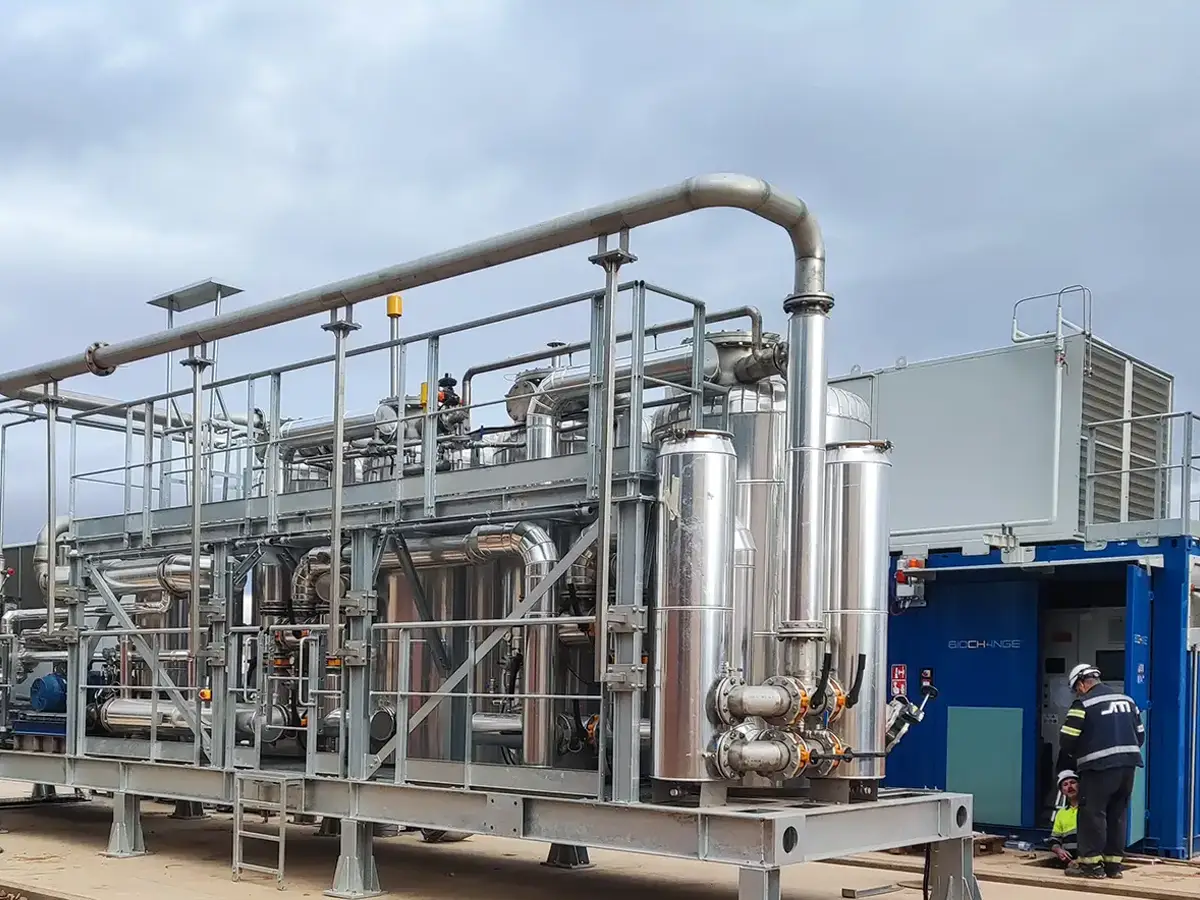Biomethane
BIOGAS
Biogas is a renewable fuel produced by the decomposition of organic matter in the absence of oxygen, a process known as anaerobic digestion. It is mainly composed of methane (CH4) and carbon dioxide (CO2), with traces of other gases such as nitrogen, hydrogen, hydrogen sulfide, and water vapor.
The organic matter used for biogas production can come from various sources, such as agricultural residues, animal manure, food waste, and sludge from wastewater treatment plants, among others. This anaerobic decomposition process takes place in a biological reactor or digester.


BIOGAS
Biogas is a renewable fuel produced by the decomposition of organic matter in the absence of oxygen, a process known as anaerobic digestion. It is mainly composed of methane (CH4) and carbon dioxide (CO2), with traces of other gases such as nitrogen, hydrogen, hydrogen sulfide, and water vapor.
The organic matter used for biogas production can come from various sources, such as agricultural residues, animal manure, food waste, and sludge from wastewater treatment plants, among others. This anaerobic decomposition process takes place in a biological reactor or digester.

FROM BIOGAS TO BIOMETHANE
Biomethane is biogas that has been purified and enriched to reach a composition very similar to conventional natural gas.
The produced biogas undergoes a purification process to remove contaminants and increase its methane concentration. This process, known as “upgrading” or “purification,” primarily involves the removal of carbon dioxide and other unwanted gases. The result is a high-quality gas with a methane content of around 98%.
Biomethane has various applications, with one of the most important being its use as fuel for vehicles, including passenger cars, commercial vehicles, and public transport. It can also be injected into the natural gas grid for distribution and use in domestic, industrial, and commercial settings, contributing to the diversification of energy sources and the reduction of greenhouse gas emissions.
PSA (Pressure Swing Adsorption) or High-Pressure Water Scrubbing
This is one of the oldest and most widely used technologies for purifying biogas. It works by capturing carbon dioxide (CO2) in water at high pressure in the first stage, and then releasing the CO2 by reducing the pressure in the second stage.
Chemical Absorption using Amines is a technique in which carbon dioxide (CO2) is selectively absorbed into an amine solution, a type of chemical compound. Subsequently, this amine solution is regenerated by heating, releasing the CO2 for collection.
Although it can have high electrical consumption, it is easier to handle and may have fewer maintenance issues compared to other technologies.
Membrane Separation
This technology is newer and relies on the permeability of membranes to separate biogas components based on their molecular size.
The biogas passes through porous membranes that allow methane to pass more easily than carbon dioxide and other gases, resulting in purer biomethane.
Although it can have high electrical consumption, it is easier to handle and may have fewer maintenance issues compared to other technologies.
Chemical Absorption using Amines
Chemical Absorption using Amines is a technique in which carbon dioxide (CO2) is selectively absorbed into an amine solution, a type of chemical compound. Subsequently, this amine solution is regenerated by heating, releasing the CO2 for collection.
This technology can offer superior efficiency in terms of energy consumption, especially for large volumes of biogas or biogas with high levels of hydrogen sulfide (H2S). However, it is important to note that the regeneration of the amines may require additional heat consumption.
Each technology presents its own characteristics and specific considerations. The choice between them will depend on factors such as the size of the plant, the composition of the biogas, the quality standards of the final product, and the associated operating and maintenance costs.
PSA (Pressure Swing Adsorption) or High-Pressure Water Scrubbing
This is one of the oldest and most widely used technologies for purifying biogas. It works by capturing carbon dioxide (CO2) in water at high pressure in the first stage, and then releasing the CO2 by reducing the pressure in the second stage.
Chemical Absorption using Amines is a technique in which carbon dioxide (CO2) is selectively absorbed into an amine solution, a type of chemical compound. Subsequently, this amine solution is regenerated by heating, releasing the CO2 for collection.
Although it can have high electrical consumption, it is easier to handle and may have fewer maintenance issues compared to other technologies.
Membrane Separation
This technology is newer and relies on the permeability of membranes to separate biogas components based on their molecular size.
The biogas passes through porous membranes that allow methane to pass more easily than carbon dioxide and other gases, resulting in purer biomethane.
Although it can have high electrical consumption, it is easier to handle and may have fewer maintenance issues compared to other technologies.
Chemical Absorption using Amines
Chemical Absorption using Amines is a technique in which carbon dioxide (CO2) is selectively absorbed into an amine solution, a type of chemical compound. Subsequently, this amine solution is regenerated by heating, releasing the CO2 for collection.
This technology can offer superior efficiency in terms of energy consumption, especially for large volumes of biogas or biogas with high levels of hydrogen sulfide (H2S). However, it is important to note that the regeneration of the amines may require additional heat consumption.
Each technology presents its own characteristics and specific considerations. The choice between them will depend on factors such as the size of the plant, the composition of the biogas, the quality standards of the final product, and the associated operating and maintenance costs.
